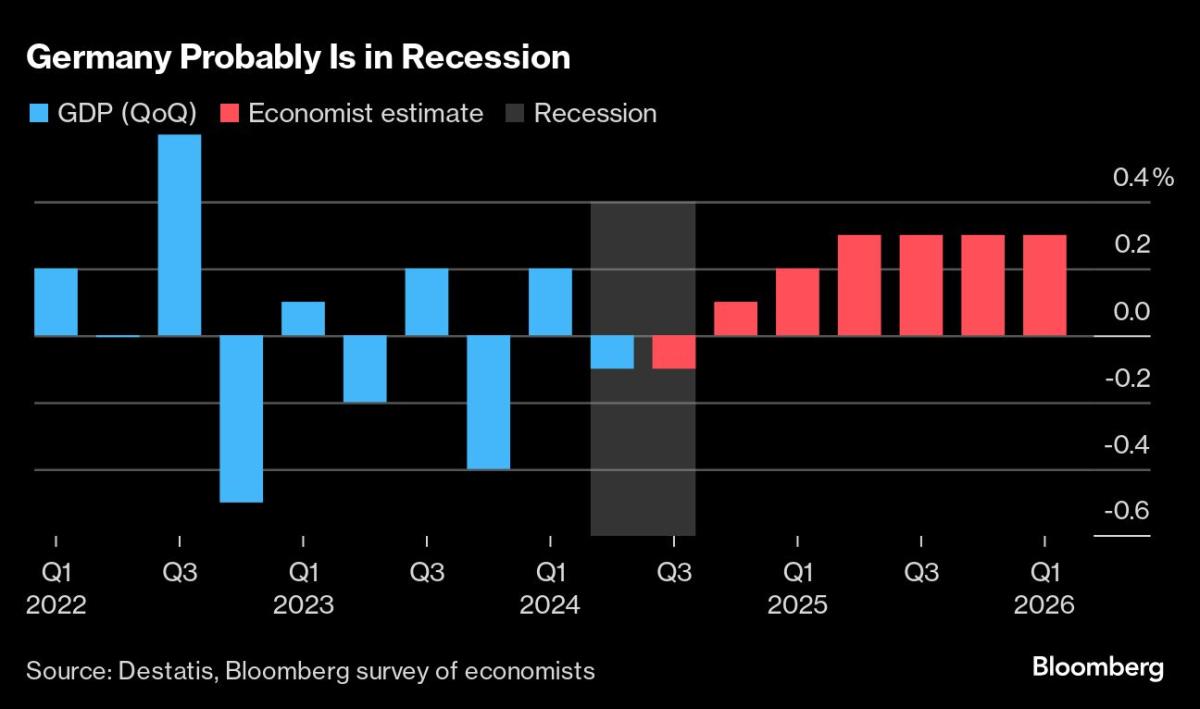CryptoCurrency
The World’s $100 Trillion Fiscal Timebomb Keeps Ticking

(Bloomberg) — Even before global finance chiefs fly into Washington over the next few days, they’ve been urged in advance by the International Monetary Fund to tighten their belts.
Most Read from Bloomberg
Two weeks ahead of a potentially era-defining US election, and with the world’s recent inflation crisis barely behind it, ministers and central bankers gathering in the nation’s capital face intensifying calls to get their fiscal houses in order while they still can.
The fund, whose annual meetings begin there on Monday, has already pointed to some of the themes it hopes to press home with a barrage of projections and studies on the global economy in coming days.
The IMF’s Fiscal Monitor on Wednesday will feature a warning that public debt levels are set to reach $100 trillion this year, driven by China and the US. Managing Director Kristalina Georgieva, in a speech on Thursday, stressed how that mountain of borrowing is weighing on the world.
“Our forecasts point to an unforgiving combination of low growth and high debt — a difficult future,” she said. “Governments must work to reduce debt and rebuild buffers for the next shock — which will surely come, and maybe sooner than we expect.”
Some finance ministers may get further reminders even before the week is over.
UK Chancellor of the Exchequer Rachel Reeves has already faced an IMF warning of the risk of a market backlash if debt doesn’t stabilize. Tuesday marks the last release of public finance data before her Oct. 30 budget.
What Bloomberg Economics Says:
“For all the talk of black holes, the overall effect of Reeves budget will be a policy that’s looser, not tighter, relative to the previous government’s plans.”
—Ana Andrade and Dan Hanson, economists. For full analysis, click here
Meanwhile, Moody’s Ratings has slated Friday for a possible report on France, which faces intense investor scrutiny at present. With its assessment one step higher than major competitors, markets will watch for any cut in the outlook.
As for the biggest borrowers of all, the glimpse of the IMF’s report already published contains a grim admonishment: your public finances are everyone’s problem.
“Elevated debt levels and uncertainty surrounding fiscal policy in systemically important countries, such as China and the United States, can generate significant spillovers in the form of higher borrowing costs and debt-related risks in other economies,” the fund said.
Elsewhere in the coming week, a rate cut in Canada and a hike in Russia are among the possible central bank moves anticipated by economists.
Click here for what happened in the past week, and below is our wrap of what’s coming up in the global economy.
US and Canada
Economists see a pair of home sales reports showing that declining mortgage rates are merely helping to stabilize the US residential real estate market. On Wednesday, the National Association of Realtors will issue data on contract closings for previously owned homes, followed a day later by government figures on sales of new homes.
Economists project modest increases in September sales of both existing and new homes. Resales remain hamstrung by limited inventory that’s keeping asking prices elevated and hurting affordability. While purchases of previously owned properties remain near the weakest pace since 2010, builders have capitalized: New-home sales have gradually picked up over the past two years with the help of incentives.
Other US data in the coming week include September durable goods orders, plus capital goods shipments that will help economists fine-tune their estimates of third-quarter economic growth. The Federal Reserve also issues its Beige Book, an anecdotal readout of the economy.
Regional Fed officials speaking in the coming week include Jeffrey Schmid, Mary Daly and Lorie Logan.
Meanwhile, the Bank of Canada is increasingly expected to cut rates by 50 basis points after inflation cooled to 1.6% in September and some measures of the labor market remain weak.
Europe, Middle East, Africa
As with other regions, attention will largely be focused on Washington; more than a dozen appearances of European Central Bank’s Governing Council members are scheduled stateside.
That includes President Christine Lagarde, who’ll be interviewed by Bloomberg Television’s Francine Lacqua in Washington on Tuesday.
Similarly, Bank of England Governor Andrew Bailey will speak in New York on Tuesday, while Swiss National Bank President Martin Schlegel is scheduled to appear on Friday.
Among euro-area economic reports, consumer confidence on Wednesday, purchasing manager indexes the following day, and the ECB’s inflation expectations survey on Friday may be the highlights. Similarly, Germany’s Ifo Institute will release its closely watched business confidence gauge at the end of the week.
Aside from the possible rating assessment on France, S&P may also release reports on Belgium and Finland on Friday.
Turning east, two central bank decisions are likely to draw attention, starting on Tuesday with Hungary, which may keep borrowing costs unchanged.
The Bank of Russia has signaled that continued inflationary pressures could lead to another rate hike on Friday. They lifted it 100 basis points to 19% in September, and a similar move would return the rate to the 20% level imposed in an emergency increase after President Vladimir Putin began the February 2022 full-scale invasion of Ukraine.
Finally, data on Wednesday from South Africa is expected to show inflation slowed to 3.8% in September, boosting the chances of another rate cut next month. The central bank said it now forecasts consumer-price growth to stay in the bottom half of its 3% to 6% target band over the next three quarters.
Asia
Lenders in China, with a nudge from the People’s Bank of China, are expected to join the campaign to revive business activity by trimming their loan prime rates on Monday. The 1-year and 5-year rates are seen sliding by 20 basis points to 3.15% and 3.65%, respectively.
At the end of the week, data will show if the nation’s industrial profits bounced back in September after slumping more than 17% in August. The most recent numbers showed the economy expanding at the lowest pace in six quarters during that three-month period.
Elsewhere, the region gets a cluster of PMIs on Thursday, including from Japan, Australia and India.
Singapore is forecast to report Wednesday that consumer inflation slowed in September, with price growth updates for that month also due from Hong Kong and Malaysia.
On Friday, Japan will report Tokyo CPI for October, a key indicator that will capture corporate price changes at the start of the fiscal second half.
South Korea will release third-quarter growth figures on Wednesday that may show the economy’s momentum has slowed marginally.
During the week, South Korea releases early trade statistics for October, with Taiwan and New Zealand releasing trade numbers for September.
Among the region’s central banks, many leading officials will attend the IMF meetings in Washington. Reserve Bank of Australia Deputy Governor Andrew Hauser holds a fireside chat on Monday, and three days later the bank publishes its annual report.
Reserve Bank of New Zealand chief Adrian Orr speaks on policy on the sidelines of the IMF confab, and Uzbekistan’s central bank will decide Thursday whether to pause for a second meeting following its July rate cut.
Latin America
Brazil watchers will be keen to see the weekly forecasts in the central bank’s so-called Focus survey due on Monday.
Expectations for inflation, borrowing costs and debt metrics have lately taken a decidedly gloomy turn given doubts about the government’s fiscal discipline.
In Mexico, GDP proxy data should be consistent with the loss of momentum that has many economists marking down their third-quarter growth forecasts. The economy is expected to slow for a third year in 2024.
GDP proxy data for Argentina will probably show South America’s second-biggest economy sputtering and still in the grip of a recession that’s likely to extend into 2025.
Paraguay’s central bank holds its rate setting meeting; policymakers have kept borrowing costs at 6% for the past six months with inflation running slightly above the 4% target.
On the prices front, neither investors nor policymakers will be cheered by mid-month inflation reports from Brazil and Mexico given the early consensus for higher headline readings.
The data here will likely do nothing to dent the prospects of Brazil’s central bank tightening policy again on Nov. 6, while at the same time giving Banxico pause about a third straight cut at its Nov. 14 gathering.
–With assistance from Laura Dhillon Kane, Brian Fowler, Robert Jameson, Monique Vanek, Vince Golle, Brendan Scott and William Horobin.
Most Read from Bloomberg Businessweek
©2024 Bloomberg L.P.
CryptoCurrency
Do millionaires keep their money in checking accounts?

The habits of millionaires are a topic of interest when it comes to financial advice. After all, unless they received a large chunk of money as an inheritance or gift, most millionaires had to be smart with their money to get where they are.
Learning how millionaires accumulate wealth — and where they keep it — can provide valuable insights for anyone focused on growing their money. One common question is whether or not millionaires keep money in checking accounts.
Studies show that in recent years, millionaires are keeping a significant portion of their wealth in cash. According to CNBC’s , that portion was about 24% in 2023. While this doesn’t necessarily mean a quarter of a millionaire’s wealth is sitting in a checking account, it does indicate the importance of maintaining liquid assets. And a checking account can be a helpful tool for doing so — whether or not you’re a millionaire.
Anyone, regardless of net worth, can find value in a checking account. Checking accounts allow unlimited deposits and withdrawals, check writing, bill pay, and other features to help you manage your money day-to-day.
While millionaires may keep large portions of their wealth in other deposit accounts and investments, some may use a checking account to manage daily spending. Millionaires also recognize the importance of having liquid assets, like funds in checking and savings accounts. Accessible cash lets you cover unexpected expenses without needing to sell off investments, borrow money, or pay a penalty for tapping your retirement savings early.
The amount of money a millionaire keeps in their checking account is highly personal and depends on preference. However, because checking accounts rarely earn competitive — if any — interest, some millionaires intentionally limit their checking account balance. Some may choose to keep the bare minimum, such as a couple of months’ worth of essential expenses, in their checking accounts, keeping the rest of their wealth in more lucrative assets.
Regardless of preference, it would be surprising for a millionaire to keep more than $250,000 in a single checking account. That’s because the Federal Deposit Insurance Corp. (FDIC) only insures up to $250,000 in deposits per institution, per account holder.
While millionaires may use checking accounts for day-to-day financial transactions, they may also use some of the following accounts in addition to, or in place of, a checking account:
-
Savings accounts: Like checking accounts, savings accounts provide a high degree of liquidity, allowing you to access your money as needed for regular or unexpected expenses. High-yield savings accounts, in particular, give millionaires an extra bang for their buck. Some of the best accounts currently offer rates upwards of 4% versus the national average savings account rate of 0.46%.
-
Cash management accounts: Cash management accounts (CMAs) pay competitive interest rates while maintaining more accessibility than a savings account. Some CMAs come with a debit card and ATM access, and many provide extended FDIC coverage limits by “sweeping” additional deposits into partner banks. CMAs are available at brokerages, not banks, facilitating easy transfers between investment and cash accounts.
-
Money market accounts: Similar to CMAs, money market accounts combine features of checking and savings accounts, often paying competitive interest rates and providing check writing and ATM access. Banks and credit unions offer these accounts, which are federally insured. Minimum opening deposit and minimum balance requirements are often higher than those for standard savings accounts.
-
Retirement and tax-advantaged accounts: Millionaires understand the importance of investing for their later years, and retirement accounts such as 401(k)s and IRAs allow them to do so in a tax-advantaged way. Some retirement accounts, like 401(k)s, are offered by certain employers. Others, such as traditional and Roth IRAs, are available to anyone.
-
Brokerage accounts: The IRS limits contributions to tax-advantaged accounts, and millionaires typically invest beyond these limits. They do so with taxable brokerage accounts, which can hold investments such as stocks, bonds, and mutual funds without contribution limits.
-
Other investments, like real estate, commodities, and art: Some millionaires may decide to diversify their portfolio with other investment types. These could include real estate investments, such as investment properties or real estate investment trusts (REITs); commodities, such as metals or energy products; art; and more.
The amount of money millionaires keep in their checking accounts depends on personal preference. While some millionaires may keep six figures in their checking account to maintain a comfortable cash cushion, others may choose to keep the bare minimum in checking. You wouldn’t expect millionaires to keep more than $250,000 in a checking account, however, because balances over this threshold aren’t typically insured.
There’s no single bank that’s a favorite among millionaires; it’s another matter of preference. However, millionaires are likely to bank with institutions that offer private banking to those who meet specific financial requirements. Private banking may include wealth planning services, waived fees, dedicated bankers, and additional perks. J.P. Morgan Private Bank, Citi Private Bank, and Bank of America Private Bank are among some of the most popular banks for millionaires.
Billionaires may have checking accounts, but they likely use accounts that cater to ultra-high-net-worth individuals. These accounts may come with perks such as a dedicated banker, waived fees, and competitive interest rates. Alternatively, billionaires may opt for a cash management account with higher FDIC insurance coverage limits and checking account features.
No rule says you can’t have a million dollars in a checking account, but FDIC insurance typically only covers up to $250,000. Plus, you can get a bigger return on your investment by keeping $1 million elsewhere. One alternative is a cash management account, which acts like a checking account but generally earns higher interest. Plus, many cash management accounts insure more than the standard $250,000 by sweeping funds into multiple partner banks.
CryptoCurrency
Lumen And Meta Join Forces To Boost AI With Flexible, On-Demand Network Solutions


Lumen Technologies, Inc. (NYSE:LUMN) shares are trading higher on Monday after the company announced it is partnering with Meta Platforms, Inc. (NASDAQ:META) to significantly increase Meta’s network capacity and help drive its AI ambitions.
Lumen’s partnership offers Meta enhanced flexibility with secure, on-demand bandwidth, supporting its complex computing requirements and enabling it to serve billions daily.
Ashley Haynes-Gaspar, Lumen’s EVP and chief revenue officer, said, “We’ve transformed our company to meet this demand. As Meta’s customers use more AI services across its platforms, we’re helping provide Meta with a seamless, effortless, and flexible network that will meet its growing needs.”
Lumen Technologies said its Private Connectivity Fabric enables long-term network capacity for Meta’s AI.
Alex-Handrah Aimé, director of Meta’s Network Investments stated, “Our AI tools are performing increasingly more complex tasks including enabling conversations in a variety of languages and translating text to images in real time, while helping people interact with the world around them in new, immersive ways.”
Lumen will report third quarter 2024 results on November 5, 2024.
Investors can gain exposure to the stock via Invesco S&P SmallCap Utilities & Communication Services ETF (NASDAQ:PSCU) and First Trust Cloud Computing ETF (NASDAQ:SKYY).
Price Action: LUMN shares are up 9.50% at $7.38 at the last check Monday.
Image via Shutterstock
Read Next:
UNLOCKED: 5 NEW TRADES EVERY WEEK. Click now to get top trade ideas daily, plus unlimited access to cutting-edge tools and strategies to gain an edge in the markets.
Get the latest stock analysis from Benzinga?
This article Lumen And Meta Join Forces To Boost AI With Flexible, On-Demand Network Solutions originally appeared on Benzinga.com
© 2024 Benzinga.com. Benzinga does not provide investment advice. All rights reserved.
CryptoCurrency
US election optimism fuels $2.2B inflows in crypto products


CoinShares said the United States and Bitcoin led crypto investment product dynamics last week amid growing optimism over a potential Republican election win in the US.
CryptoCurrency
Quantum computer ‘threat’ to crypto is exaggerated — for now


Bitcoin’s private keys won’t be breached any time soon, but the industry still needs to transition to “post-quantum cryptography.”
CryptoCurrency
European investors pour record $105B into US Bitcoin ETFs


Despite record European inflows, Bitcoin has been unable to recover above the $70,000 psychological level since July.
CryptoCurrency
ApeCoin (APE) price jumps 100% on ApeChain launch


Apechain mainnet launch and LayerZero’s integration translated to 100% price upside for APE in recent days.
-

 Science & Environment1 month ago
Science & Environment1 month agoHyperelastic gel is one of the stretchiest materials known to science
-

 Technology4 weeks ago
Technology4 weeks agoIs sharing your smartphone PIN part of a healthy relationship?
-

 Science & Environment1 month ago
Science & Environment1 month ago‘Running of the bulls’ festival crowds move like charged particles
-

 Science & Environment1 month ago
Science & Environment1 month agoHow to unsnarl a tangle of threads, according to physics
-

 Science & Environment1 month ago
Science & Environment1 month agoMaxwell’s demon charges quantum batteries inside of a quantum computer
-

 Technology1 month ago
Technology1 month agoWould-be reality TV contestants ‘not looking real’
-

 Science & Environment4 weeks ago
Science & Environment4 weeks agoX-rays reveal half-billion-year-old insect ancestor
-

 Science & Environment1 month ago
Science & Environment1 month agoSunlight-trapping device can generate temperatures over 1000°C
-

 Science & Environment1 month ago
Science & Environment1 month agoLiquid crystals could improve quantum communication devices
-

 Science & Environment1 month ago
Science & Environment1 month agoQuantum ‘supersolid’ matter stirred using magnets
-

 Womens Workouts4 weeks ago
Womens Workouts4 weeks ago3 Day Full Body Women’s Dumbbell Only Workout
-

 Technology3 weeks ago
Technology3 weeks agoUkraine is using AI to manage the removal of Russian landmines
-

 TV3 weeks ago
TV3 weeks agoসারাদেশে দিনব্যাপী বৃষ্টির পূর্বাভাস; সমুদ্রবন্দরে ৩ নম্বর সংকেত | Weather Today | Jamuna TV
-

 Science & Environment1 month ago
Science & Environment1 month agoLaser helps turn an electron into a coil of mass and charge
-

 Science & Environment1 month ago
Science & Environment1 month agoWhy this is a golden age for life to thrive across the universe
-

 Science & Environment1 month ago
Science & Environment1 month agoA new kind of experiment at the Large Hadron Collider could unravel quantum reality
-

 Science & Environment1 month ago
Science & Environment1 month agoQuantum forces used to automatically assemble tiny device
-

 News3 weeks ago
News3 weeks agoMassive blasts in Beirut after renewed Israeli air strikes
-

 News2 weeks ago
News2 weeks agoNavigating the News Void: Opportunities for Revitalization
-

 Football3 weeks ago
Football3 weeks agoRangers & Celtic ready for first SWPL derby showdown
-

 Science & Environment1 month ago
Science & Environment1 month agoA slight curve helps rocks make the biggest splash
-

 Science & Environment1 month ago
Science & Environment1 month agoNerve fibres in the brain could generate quantum entanglement
-

 Science & Environment1 month ago
Science & Environment1 month agoHow to wrap your mind around the real multiverse
-

 Science & Environment1 month ago
Science & Environment1 month agoITER: Is the world’s biggest fusion experiment dead after new delay to 2035?
-

 News1 month ago
News1 month ago▶️ Hamas in the West Bank: Rising Support and Deadly Attacks You Might Not Know About
-

 MMA3 weeks ago
MMA3 weeks agoJulianna Peña trashes Raquel Pennington’s behavior as champ
-
Business3 weeks ago
DoJ accuses Donald Trump of ‘private criminal effort’ to overturn 2020 election
-

 Business3 weeks ago
Business3 weeks agoWhen to tip and when not to tip
-

 News1 month ago
News1 month ago▶️ Media Bias: How They Spin Attack on Hezbollah and Ignore the Reality
-

 Science & Environment1 month ago
Science & Environment1 month agoNuclear fusion experiment overcomes two key operating hurdles
-

 Science & Environment1 month ago
Science & Environment1 month agoTime travel sci-fi novel is a rip-roaringly good thought experiment
-

 Technology3 weeks ago
Technology3 weeks agoMicrophone made of atom-thick graphene could be used in smartphones
-

 Technology3 weeks ago
Technology3 weeks agoSamsung Passkeys will work with Samsung’s smart home devices
-

 News2 weeks ago
News2 weeks ago▶ Hamas Spent $1B on Tunnels Instead of Investing in a Future for Gaza’s People
-

 MMA2 weeks ago
MMA2 weeks ago‘Uncrowned queen’ Kayla Harrison tastes blood, wants UFC title run
-

 MMA3 weeks ago
MMA3 weeks agoPereira vs. Rountree prediction: Champ chases legend status
-

 Sport3 weeks ago
Sport3 weeks agoBoxing: World champion Nick Ball set for Liverpool homecoming against Ronny Rios
-

 Sport3 weeks ago
Sport3 weeks agoWales fall to second loss of WXV against Italy
-

 Science & Environment1 month ago
Science & Environment1 month agoPhysicists have worked out how to melt any material
-
News1 month ago
the pick of new debut fiction
-

 News1 month ago
News1 month agoOur millionaire neighbour blocks us from using public footpath & screams at us in street.. it’s like living in a WARZONE – WordupNews
-

 Technology4 weeks ago
Technology4 weeks agoWhy Machines Learn: A clever primer makes sense of what makes AI possible
-

 Technology1 month ago
Technology1 month agoMeta has a major opportunity to win the AI hardware race
-

 Technology3 weeks ago
Technology3 weeks agoMusk faces SEC questions over X takeover
-

 Sport3 weeks ago
Sport3 weeks agoWorld’s sexiest referee Claudia Romani shows off incredible figure in animal print bikini on South Beach
-

 Technology3 weeks ago
Technology3 weeks agoThe best budget robot vacuums for 2024
-

 Sport3 weeks ago
Sport3 weeks agoMan City ask for Premier League season to be DELAYED as Pep Guardiola escalates fixture pile-up row
-

 MMA3 weeks ago
MMA3 weeks agoDana White’s Contender Series 74 recap, analysis, winner grades
-

 News3 weeks ago
News3 weeks agoFamily plans to honor hurricane victim using logs from fallen tree that killed him
-

 Sport3 weeks ago
Sport3 weeks agoCoco Gauff stages superb comeback to reach China Open final
-

 Technology3 weeks ago
Technology3 weeks agoThis AI video generator can melt, crush, blow up, or turn anything into cake
-

 News3 weeks ago
News3 weeks agoGerman Car Company Declares Bankruptcy – 200 Employees Lose Their Jobs
-

 Technology3 weeks ago
Technology3 weeks agoTexas is suing TikTok for allegedly violating its new child privacy law
-

 Sport3 weeks ago
Sport3 weeks agoSturm Graz: How Austrians ended Red Bull’s title dominance
-

 Money3 weeks ago
Money3 weeks agoWetherspoons issues update on closures – see the full list of five still at risk and 26 gone for good
-

 MMA3 weeks ago
MMA3 weeks agoPereira vs. Rountree preview show live stream
-

 News2 weeks ago
News2 weeks agoHeavy strikes shake Beirut as Israel expands Lebanon campaign
-

 TV2 weeks ago
TV2 weeks agoLove Island star sparks feud rumours as one Islander is missing from glam girls’ night
-

 Business3 weeks ago
Business3 weeks agoChancellor Rachel Reeves says she needs to raise £20bn. How might she do it?
-

 MMA3 weeks ago
MMA3 weeks agoAlex Pereira faces ‘trap game’ vs. Khalil Rountree
-

 News3 weeks ago
News3 weeks agoHeartbreaking end to search as body of influencer, 27, found after yacht party shipwreck on ‘Devil’s Throat’ coastline
-
Business3 weeks ago
Sterling slides after Bailey says BoE could be ‘a bit more aggressive’ on rates
-

 News3 weeks ago
News3 weeks ago‘Blacks for Trump’ and Pennsylvania progressives play for undecided voters
-

 Science & Environment1 month ago
Science & Environment1 month agoPhysicists are grappling with their own reproducibility crisis
-
Business3 weeks ago
Bank of England warns of ‘future stress’ from hedge fund bets against US Treasuries
-

 Football3 weeks ago
Football3 weeks agoSimo Valakari: New St Johnstone boss says Scotland special in his heart
-

 TV3 weeks ago
TV3 weeks agoPhillip Schofield accidentally sets his camp on FIRE after using emergency radio to Channel 5 crew
-

 News3 weeks ago
News3 weeks agoWoman who died of cancer ‘was misdiagnosed on phone call with GP’
-

 MMA3 weeks ago
MMA3 weeks agoUFC 307 preview show: Will Alex Pereira’s wild ride continue, or does Khalil Rountree shock the world?
-

 Technology3 weeks ago
Technology3 weeks agoThe best shows on Max (formerly HBO Max) right now
-

 Science & Environment3 weeks ago
Science & Environment3 weeks agoMarkets watch for dangers of further escalation
-

 Technology3 weeks ago
Technology3 weeks agoJ.B. Hunt and UP.Labs launch venture lab to build logistics startups
-

 Sport3 weeks ago
Sport3 weeks agoChina Open: Carlos Alcaraz recovers to beat Jannik Sinner in dramatic final
-

 TV3 weeks ago
TV3 weeks agoMaayavi (මායාවී) | Episode 23 | 02nd October 2024 | Sirasa TV
-

 Technology3 weeks ago
Technology3 weeks agoPopular financial newsletter claims Roblox enables child sexual abuse
-

 News3 weeks ago
News3 weeks agoHull KR 10-8 Warrington Wolves – Robins reach first Super League Grand Final
-

 Technology3 weeks ago
Technology3 weeks agoOpenAI secured more billions, but there’s still capital left for other startups
-
Business3 weeks ago
Head of UK Competition Appeal Tribunal to step down after rebuke for serious misconduct
-
Business3 weeks ago
The search for Japan’s ‘lost’ art
-

 Sport3 weeks ago
Sport3 weeks agoAaron Ramsdale: Southampton goalkeeper left Arsenal for more game time
-

 News3 weeks ago
News3 weeks agoBalancing India and China Is the Challenge for Sri Lanka’s Dissanayake
-

 Entertainment3 weeks ago
Entertainment3 weeks ago“Golden owl” treasure hunt launched decades ago may finally have been solved
-

 Science & Environment1 month ago
Science & Environment1 month agoA tale of two mysteries: ghostly neutrinos and the proton decay puzzle
-
Business4 weeks ago
Eurosceptic Andrej Babiš eyes return to power in Czech Republic
-

 Sport1 month ago
Sport1 month agoJoshua vs Dubois: Chris Eubank Jr says ‘AJ’ could beat Tyson Fury and any other heavyweight in the world
-
News1 month ago
The Project Censored Newsletter – May 2024
-

 Technology4 weeks ago
Technology4 weeks agoArtificial flavours released by cooking aim to improve lab-grown meat
-

 Technology3 weeks ago
Technology3 weeks agoUniversity examiners fail to spot ChatGPT answers in real-world test
-

 Technology3 weeks ago
Technology3 weeks agoEpic Games CEO Tim Sweeney renews blast at ‘gatekeeper’ platform owners
-

 News3 weeks ago
News3 weeks agoLiverpool secure win over Bologna on a night that shows this format might work
-

 Technology3 weeks ago
Technology3 weeks agoMicrosoft just dropped Drasi, and it could change how we handle big data
-

 Technology3 weeks ago
Technology3 weeks agoApple iPhone 16 Plus vs Samsung Galaxy S24+
-

 Health & fitness3 weeks ago
Health & fitness3 weeks agoNHS surgeon who couldn’t find his scalpel cut patient’s chest open with the penknife he used to slice up his lunch
-

 Technology3 weeks ago
Technology3 weeks agoHow to disable Google Assistant on your Pixel Watch 3
-

 Money3 weeks ago
Money3 weeks agoPub selling Britain’s ‘CHEAPEST’ pints for just £2.60 – but you’ll have to follow super-strict rules to get in
-
Business3 weeks ago
Can liberals be trusted with liberalism?
-

 Technology3 weeks ago
Technology3 weeks agoA very underrated horror movie sequel is streaming on Max
-

 MMA3 weeks ago
MMA3 weeks agoKetlen Vieira vs. Kayla Harrison pick, start time, odds: UFC 307
-

 MMA3 weeks ago
MMA3 weeks agoHow to watch Salt Lake City title fights, lineup, odds, more
-

 Technology3 weeks ago
Technology3 weeks agoAmazon’s Ring just doubled the price of its alarm monitoring service for grandfathered customers

You must be logged in to post a comment Login